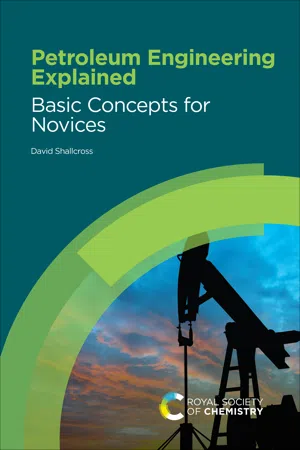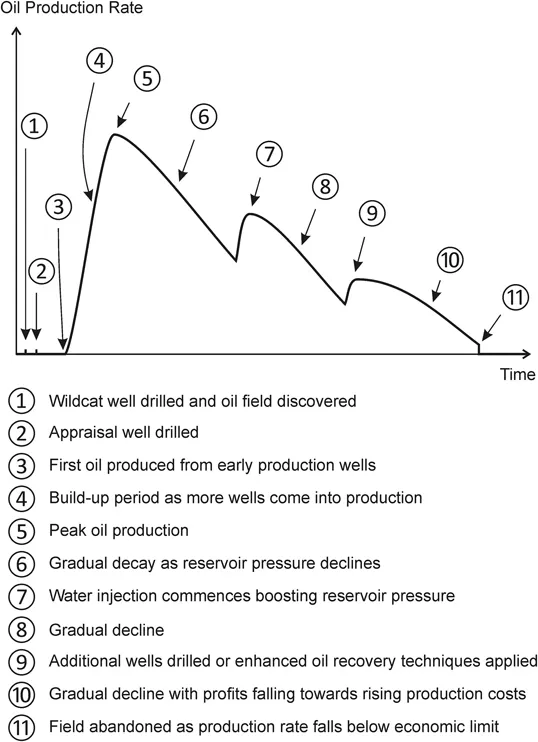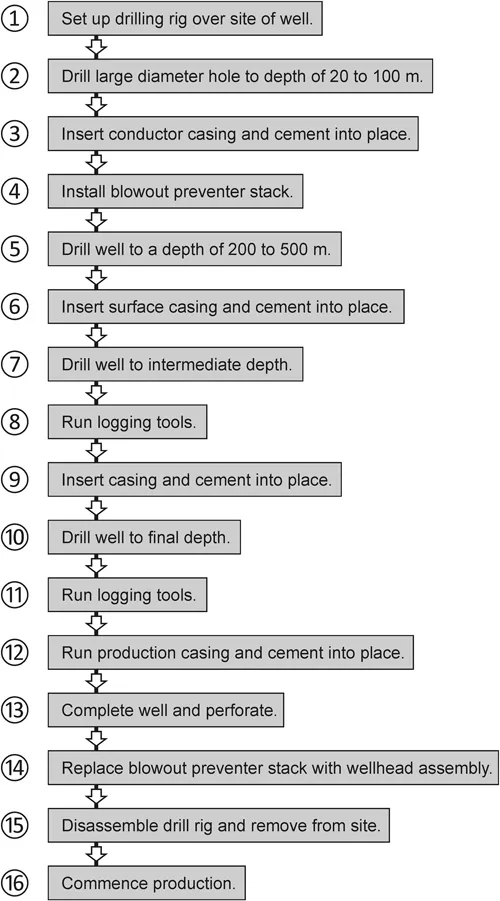![]()
1 Exploiting a Petroleum Reservoir
We may think of crude oil and natural gas as just being energy resources, but they also provide the building blocks for a range of products important for everyday life from plastics to paracetamol. In this chapter we are introduced to petroleum engineering by first considering the life cycle of a field development. How is an oil field exploited, and how is it brought on line? During the life of a field, which might span several decades, new wells will be drilled and old wells decommissioned in the pursuit of extracting as much oil and gas from a reservoir as possible. Next, we will consider the key steps in drilling an oil well, even one that might reach more than two kilometres below ground. How is a well drilled safely so deep underground? From there we look at the huge Manifa oil field development along the Saudi Arabian coast. This massive field has been developed using 27 artificial islands and 13 conventional platforms. Finally, we will consider how the book is structured.
Paracetamol – it's the most commonly used medication for the treatment of mild pain and fever in the world's advanced economies. As a chemical structure, paracetamol has the formula C8H9NO2 – that means that each molecule of paracetamol contains eight carbon atoms, nine hydrogen atoms, two oxygen atoms and a single atom of nitrogen. The medication is essentially a mixture of carbon and hydrogen atoms that are linked in a single specific way. Paracetamol can be formed by any one of several sets of reactions starting from phenol, another compound containing, carbon, hydrogen and oxygen atoms. Phenol is ultimately derived from one single resource – crude oil. Crude oil and natural gas provide the building blocks for so many very different compounds and products in the modern world. Most pharmaceuticals are derived from crude oil, if you go back far enough in the production chain. Petrol, jet fuel, ship bunker oil and diesel are all derived from oil and gas, as are plastics, paints, coatings, solvents and lubricants. Crude oil and natural gas, known collectively as petroleum, or hydrocarbons, are vital to everyone's way of life in the world today.
Crude oil and natural gas were formed over hundreds of millions of years in rock far below the Earth's surface. Once formed, the liquid and gas slowly migrated over time towards the surface, through the continuous network of tiny pores that are present in many of the rock formations that make up the Earth's crust. The oil and gas continued to move to the surface until they either eventually broke through the ground and were lost to the atmosphere, or became trapped by folds in the rocks or, in pockets beneath impermeable layers.
Geologists and geoscientists use a range of tools to identify likely locations in which oil and gas might lie trapped beneath the surface. Sometimes these locations are on land, but they may also lie beneath the sea floor. A company looking to discover a new petroleum reserve will bring together a team of geologists and others to identify the best location to drill an exploratory well, also known as a wildcat well. The subsurface geology of the prospective site will be evaluated using geological data derived from seismic and other surveys. Of course, not all wildcat wells are successful. Sometimes the formation contains only water, without any trace of oil or gas, but sometimes hydrocarbons are present. Drilling an exploratory well where no other wells have been drilled before brings not only financial risks, but physical risks as well. A formation under high pressure might be unexpectedly encountered, potentially leading to an uncontrolled blowout. A dry well that does not yield any hydrocarbons will be plugged and abandoned. If, however, oil and gas is discovered, preliminary tests will be conducted on the flow rates and pressures achieved before the well is temporarily abandoned. Samples of the oil and gas produced will be analysed to characterise the quality of the discovery. The company will return to the site later to complete the well and possibly to bring it into production if the economic analysis warrants it.
1.1 Life Cycle of a Field Development
With a new oil or gas field discovered, the size of the reserve must be evaluated. This allows the company to make informed decisions on the long-term future regarding the exploitation of the reserve. Appraisal wells are drilled in order to better understand the extent and size of the reserve. Again, a team of geologists and petroleum engineers will determine the best locations for these wells. If the extent of a field warrants the full scale development of the field, then these initial appraisal wells can be brought into production later. In the meantime, while decisions are taken as to how best to develop the field, the wells will be temporarily abandoned, being plugged and sealed.
Bringing a new field into production requires a significant amount of infrastructure to be developed before the first drop of oil, or first cubic metre of gas, can be produced. A field on land will be able to be developed quicker than one at sea. Company engineers will need to answer a range of important design questions, while ensuring that all local laws and standards are met:
- Where within the field, should the wells be drilled?
- How far apart should the wells be drilled?
- What processing will be required in the field before the oil or natural gas can be exported to a refinery or other processing facility? If significant quantities of water need to be separated from the oil, will it be necessary to treat this water, or can it be simply reinjected back into the formation?
- How will the oil or natural gas be exported? If a pipeline is to be used to export the produced fluids, how big will it be, and what route will it follow?
- Where will the oil or gas be exported to?
The refinery that might ultimately receive the oil may need to be upgraded before the oil can be processed. The oil produced from some fields might contain relatively high levels of sulfur. High sulfur-content oils will need to be processed in facilities designed to withstand the corrosive effects of the sulfur.
If the petroleum field is located under the sea floor then its successful exploitation might require the construction of an offshore platform, a time-consuming activity that involves massive upfront investment before profits might flow.
Once the first production wells are drilled and completed, oil and natural gas will begin to flow, generating revenue for the project. Figure 1.1 captures the typical life cycle of an onshore field from the first wildcat well to the eventual abandonment of the field. Such a life cycle will most likely span several decades, if not more than half a century.
Figure 1.1 Major stages in the exploitation of an oil field.
As each new well comes on stream, the rate of oil and gas recovered will continue to increase (④ in Figure 1.1) until peak oil production is reached, ⑤. After the initial build-up in production, the rate at which the oil and gas will be produced will begin decline over time, ⑥. For both oil and gas fields, as the fluids flow from the reservoir, the reservoir pressure will decline. It is this pressure that often provides the driving force to help expel the fluids from the reservoir. This phase of the oil-recovery process is known as primary recovery. Some wells might be fitted with pumps down the well to help lift the oil to the surface.
Once the production rates have fallen far enough new injection wells might be drilled. These wells allow water to be injected into the petroleum formations. The injected water will not only help to maintain the pressure in the formation, but will also act to displace the mobile oil towards the existing production wells. Water injection will lead to a boost in oil production rates, ⑦, but despite these production gains, oil production rates will begin to fall again, ⑧. This phase is known as secondary recovery. During this period, more water than oil might be produced from the wells. The water will be separated from the oil, and might be reinjected back into the well.
With oil production rates falling again, the decision might be taken to increase the productivity of the field in one of several ways.
- In-field drilling – additional wells might be drilled between the existing wells. Such wells might capture oil that is distant from the existing wells.
- Horizontal well – horizontal wells might be drilled to tap those parts of the field that are yet to yield oil in significant quantities.
- Enhanced oil recovery – gases and liquids might be injected into the formation in order to increase the mobility of the oil. Injecting steam into a formation will cause the oil's temperature to rise, decreasing the oil's viscosity and allowing the oil to flow more freely to wards the production wells. Gases such as carbon dioxide and nitrogen can also be injected.
Implementing any of the above techniques will give rise to an increase in the oil recovery rate, ⑨, yet the rates will still decay with time, ➉. Finally, a point will be reached when the income realised from selling the oil does not meet the production costs. At that time,
, the field is abandoned. The wells are plugged and the surface equipment recovered.
1.2 Drilling a Well
One of the most challenging aspects of petroleum engineering is drilling a well. Not only might the well have to be drilled to a depth of several kilometres, but a section of the well might also have to be drilled horizontally. Moreover, these wells can be drilled not only on land, but also in water up to four kilometres deep.
The key stages in drilling a well on land are shown in Figure 1.2. The first task is to bring all the equipment onto the drill site (① in Figure 1.2). This equipment will include the drilling rig itself, with its towering derrick, the rotary table that will turn the drill string once it is in the hole, and all the motors, pumps and other heavy machinery. Throughout the drilling process mud will continuous circulate through the well. As the well is drilled deeper, more mud will be required, and from time to time it will be necessary to change the formulation of the mud in use. Facilities to prepare the mud for injection, and then to treat the mud when it emerges again from the well will need to be set up. Mud tanks will also need to be set up near the derrick. The consumable equipment that will be used during drilling includes casing strings, drill bits and cement that have to be shipped in and stored ready for use. Finally, the drill site will need to be connected via landline or satellite link to the company's operations centre so that the process can be monitored in real time.
Figure 1.2 Key stages in drilling and completing a well.
With the rig set up and experienced staff on site, the first section of the well will be drilled, ②. This will be a wide hole, perhaps over half a metre in diameter. The exact diameter of the well will depend upon a number of factors, including the ultimate intended depth of the well, and the anticipated nature of the formations to be drilled through on the way to the target formation. The well will be drilled to a depth of anywhere between 20 m and 100 m, depending upon the overall well design. Once the desired depth has been reached, the drill bit will be pulled from the hole, and the conductor casing run in, ③. This is a large steel pipe slightly less in diameter than the diameter of the well bore. Once hung in place from the drilling rig, a carefully calculated volume of cement will be pumped into the well. This cement will be chased down the well by a steel and rubber plug that is itself displaced by water. By the time the plug reaches the base of the well, the cement should have been pushed back up the outside of the casing, entirely filling the space between the casing and the walls of the well. The cement is then left to set.
The conductor casing now set in place by the cement, forms the foundation for all further drilling operations. A blowout is one of the most feared events on a well site. The uncontrolled release of oil and gas under pressure to the surface can lead to fire and explosions, loss of life and severe environmental impacts. One important component in the system to prevent blowouts is the blowout preventer stack. The stack is a series of valves, located one above the other and firmly bolted to the wellhead. This stack must be installed, ④, before the well can be drilled any deeper. The stack is firmly bolted to the wellhead, the top of the conductor casing that has been cemented into place.
Using a drill bit that is small enough to fit inside the casing, the plug and the cement at the bottom of the well is then drilled through. Drilling continues as the well extends down to a depth of between 200 and 500 m, ⑤. The exact depth will again depend upon the design of the well. As the drilling bit penetrates the formations, the rig crew will be constantly extending the length of the drill string by inserting pipes around 9 m in leng...



